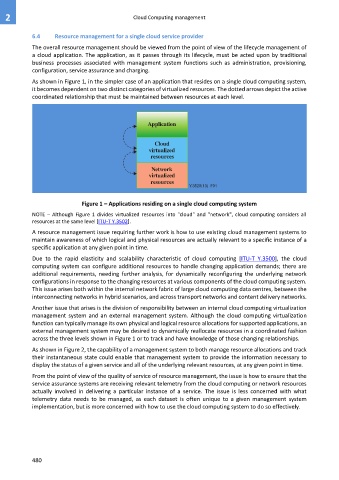Page 488 - Cloud computing: From paradigm to operation
P. 488
2 Cloud Computing management
6.4 Resource management for a single cloud service provider
The overall resource management should be viewed from the point of view of the lifecycle management of
a cloud application. The application, as it passes through its lifecycle, must be acted upon by traditional
business processes associated with management system functions such as administration, provisioning,
configuration, service assurance and charging.
As shown in Figure 1, in the simpler case of an application that resides on a single cloud computing system,
it becomes dependent on two distinct categories of virtualized resources. The dotted arrows depict the active
coordinated relationship that must be maintained between resources at each level.
Application
Cloud
virtualized
resources
Network
virtualized
resources
Y.3520(13)_F01
Figure 1 – Applications residing on a single cloud computing system
NOTE – Although Figure 1 divides virtualized resources into "cloud" and "network", cloud computing considers all
resources at the same level [ITU-T Y.3502].
A resource management issue requiring further work is how to use existing cloud management systems to
maintain awareness of which logical and physical resources are actually relevant to a specific instance of a
specific application at any given point in time.
Due to the rapid elasticity and scalability characteristic of cloud computing [ITU-T Y.3500], the cloud
computing system can configure additional resources to handle changing application demands; there are
additional requirements, needing further analysis, for dynamically reconfiguring the underlying network
configurations in response to the changing resources at various components of the cloud computing system.
This issue arises both within the internal network fabric of large cloud computing data centres, between the
interconnecting networks in hybrid scenarios, and across transport networks and content delivery networks.
Another issue that arises is the division of responsibility between an internal cloud computing virtualization
management system and an external management system. Although the cloud computing virtualization
function can typically manage its own physical and logical resource allocations for supported applications, an
external management system may be desired to dynamically reallocate resources in a coordinated fashion
across the three levels shown in Figure 1 or to track and have knowledge of those changing relationships.
As shown in Figure 2, the capability of a management system to both manage resource allocations and track
their instantaneous state could enable that management system to provide the information necessary to
display the status of a given service and all of the underlying relevant resources, at any given point in time.
From the point of view of the quality of service of resource management, the issue is how to ensure that the
service assurance systems are receiving relevant telemetry from the cloud computing or network resources
actually involved in delivering a particular instance of a service. The issue is less concerned with what
telemetry data needs to be managed, as each dataset is often unique to a given management system
implementation, but is more concerned with how to use the cloud computing system to do so effectively.
480

